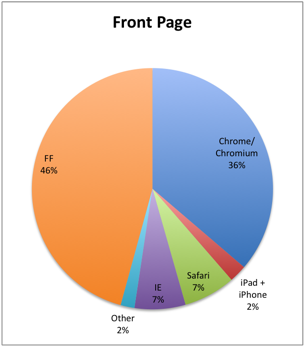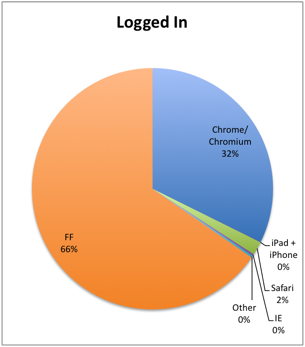KataSpace Post Mortem Part I
(This is Part I of a two part post. This first part will focus on the users and visitors and the second part will focus on some technical details.)
It’s been more than a week since we announced KataSpace and we want to let you know what we learned. We weren’t expecting quite as much attention as we got (thanks Ars!) so we didn’t focus on collecting statistics. However, we were able to collect some interesting information from the web server and space server logs. These stats are collected from the first five days of traffic. The biggest surge of traffic occured over days 2-3, following the Ars article.
Sessions
Over the five days we were looking at we saw:
- About 20,000 visitors
- About 5,100 users actually access the login screen
- About 4,300 logins to the server (3,900 unique)
Because we’re using very new technology for this demo, the majority of users that clicked through didn’t already have a browser that supports all the features required for the demo (e.g. WebGL and WebSockets). About 25% of the visitors did have a supported browser and made it to the login screen. The fact that only 5,100 users accessed login screen content implies that we successfully notified most users that they would be unable to run the demo (thanks to Modernizr‘s excellent feature detection). We were surprised that such a large fraction of visitors did have a supported browser since a recent beta or dev channel build is required. We expect this fraction to increase as browsers turn WebGL on by default with new releases, but this number is already encouraging.
Of those that made it to the login screen, about 85% were successfully logged into KataSpace (logged by the space server and verified by the web server logs for content which is only requested after a successful login). We can’t be sure why the remaining 15% didn’t make it through, but a large fraction may have turned away for non-technical reasons. Some may simply not have attempted the login or got confused by the name field, thinking they had to have an account.
User Distribution
We also broke down the visitors who hit the front page and successfully logged in by browsers:


Not surprisingly, Firefox and Chrome make up the bulk of both graphs. Since we suggested Firefox’s most recent beta version to users with an unsupported browser, it isn’t surprising to see it dominate for users that logged in. Interestingly, a few visitors with user agents that suggested an unsupported browser successfully logged in — at least one iPad and even an IE6 user agent! Presumably at least the IE6 user is overriding their user agent string. This is a great reason to use feature detection rather than browser version sniffing. Hopefully other browsers will start making larger appearances in these graphs soon.
User Experience
We didn’t automatically collect any information on user experience, but through much of the 5 days, at least one person involved in the KataSpace’s development was logged in. Based on the feedback both in KataSpace and via email and comments, the vast majority of users that got logged in seemed to have a successful experience. Basic functionality worked for most people, with the majority of issues having to do with either graphics loading too slowly or incompatibilities on platforms we did less testing on.
By far the majority of “bugs” we heard about were actually feature requests — for instance, we knew that users could walk through mountains and would “sink” into the ground because we weren’t using any physics and we intentionally kept the controls simple, so there was no way to walk or run quickly. We think one of the reasons for these complaints is a misconception about KataSpace: it is intended to demonstrate how a simple browser-based virtual world can be built on the Sirikata platform, not as a single monolithic world that has all the features of worlds like SecondLife or BlueMars.
The other major complaint was about performance, both in terms of CPU and memory use. We haven’t started looking into performance optimization much yet, so this was expected. Performance will be an ongoing concern as we move forward.
All in all, we considered the release a success. We had many positive comments and got a lot of valuable feedback. The next post will discuss some of the technical aspects and bugs, which parts of the code we encountered problems with, and our progress on resolving them.